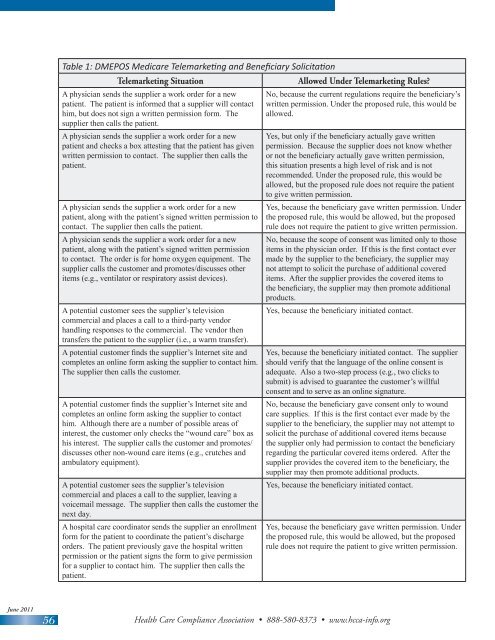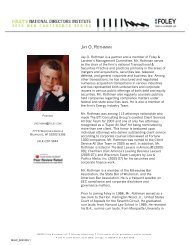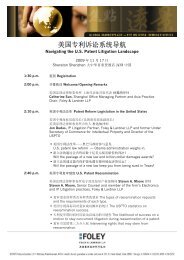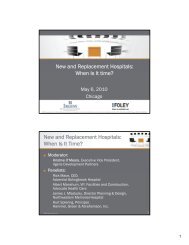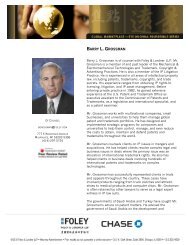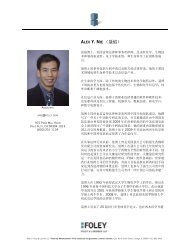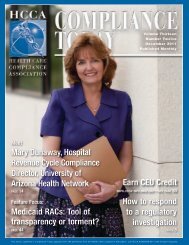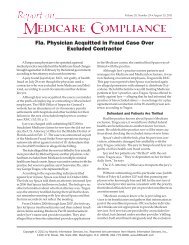Compliant DMEPOS Telemarketing - Foley & Lardner LLP
Compliant DMEPOS Telemarketing - Foley & Lardner LLP
Compliant DMEPOS Telemarketing - Foley & Lardner LLP
Create successful ePaper yourself
Turn your PDF publications into a flip-book with our unique Google optimized e-Paper software.
June 2011<br />
56<br />
Table 1: <strong>DMEPOS</strong> Medicare <strong>Telemarketing</strong> and Beneficiary Solicitation<br />
<strong>Telemarketing</strong> Situation Allowed Under <strong>Telemarketing</strong> Rules?<br />
A physician sends the supplier a work order for a new<br />
patient. The patient is informed that a supplier will contact<br />
him, but does not sign a written permission form. The<br />
supplier then calls the patient.<br />
A physician sends the supplier a work order for a new<br />
patient and checks a box attesting that the patient has given<br />
written permission to contact. The supplier then calls the<br />
patient.<br />
A physician sends the supplier a work order for a new<br />
patient, along with the patient’s signed written permission to<br />
contact. The supplier then calls the patient.<br />
A physician sends the supplier a work order for a new<br />
patient, along with the patient’s signed written permission<br />
to contact. The order is for home oxygen equipment. The<br />
supplier calls the customer and promotes/discusses other<br />
items (e.g., ventilator or respiratory assist devices).<br />
A potential customer sees the supplier’s television<br />
commercial and places a call to a third-party vendor<br />
handling responses to the commercial. The vendor then<br />
transfers the patient to the supplier (i.e., a warm transfer).<br />
A potential customer finds the supplier’s Internet site and<br />
completes an online form asking the supplier to contact him.<br />
The supplier then calls the customer.<br />
A potential customer finds the supplier’s Internet site and<br />
completes an online form asking the supplier to contact<br />
him. Although there are a number of possible areas of<br />
interest, the customer only checks the “wound care” box as<br />
his interest. The supplier calls the customer and promotes/<br />
discusses other non-wound care items (e.g., crutches and<br />
ambulatory equipment).<br />
A potential customer sees the supplier’s television<br />
commercial and places a call to the supplier, leaving a<br />
voicemail message. The supplier then calls the customer the<br />
next day.<br />
A hospital care coordinator sends the supplier an enrollment<br />
form for the patient to coordinate the patient’s discharge<br />
orders. The patient previously gave the hospital written<br />
permission or the patient signs the form to give permission<br />
for a supplier to contact him. The supplier then calls the<br />
patient.<br />
No, because the current regulations require the beneficiary’s<br />
written permission. Under the proposed rule, this would be<br />
allowed.<br />
Yes, but only if the beneficiary actually gave written<br />
permission. Because the supplier does not know whether<br />
or not the beneficiary actually gave written permission,<br />
this situation presents a high level of risk and is not<br />
recommended. Under the proposed rule, this would be<br />
allowed, but the proposed rule does not require the patient<br />
to give written permission.<br />
Yes, because the beneficiary gave written permission. Under<br />
the proposed rule, this would be allowed, but the proposed<br />
rule does not require the patient to give written permission.<br />
No, because the scope of consent was limited only to those<br />
items in the physician order. If this is the first contact ever<br />
made by the supplier to the beneficiary, the supplier may<br />
not attempt to solicit the purchase of additional covered<br />
items. After the supplier provides the covered items to<br />
the beneficiary, the supplier may then promote additional<br />
products.<br />
Yes, because the beneficiary initiated contact.<br />
Yes, because the beneficiary initiated contact. The supplier<br />
should verify that the language of the online consent is<br />
adequate. Also a two-step process (e.g., two clicks to<br />
submit) is advised to guarantee the customer’s willful<br />
consent and to serve as an online signature.<br />
No, because the beneficiary gave consent only to wound<br />
care supplies. If this is the first contact ever made by the<br />
supplier to the beneficiary, the supplier may not attempt to<br />
solicit the purchase of additional covered items because<br />
the supplier only had permission to contact the beneficiary<br />
regarding the particular covered items ordered. After the<br />
supplier provides the covered item to the beneficiary, the<br />
supplier may then promote additional products.<br />
Yes, because the beneficiary initiated contact.<br />
Yes, because the beneficiary gave written permission. Under<br />
the proposed rule, this would be allowed, but the proposed<br />
rule does not require the patient to give written permission.<br />
Health Care Compliance Association • 888-580-8373 • www.hcca-info.org


